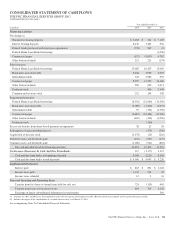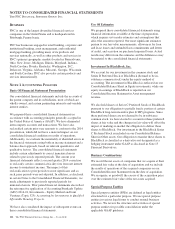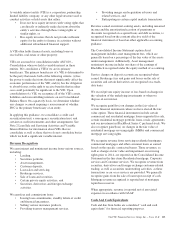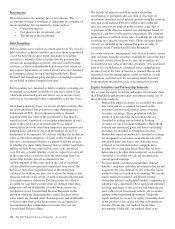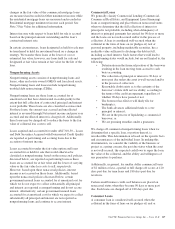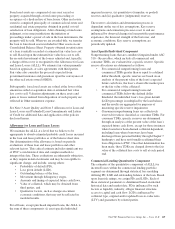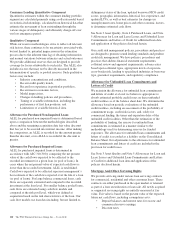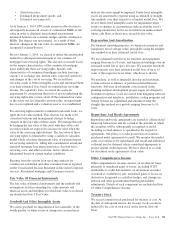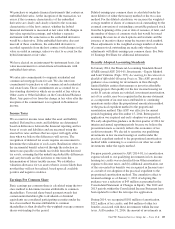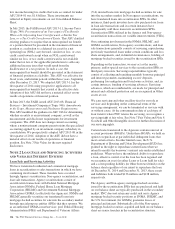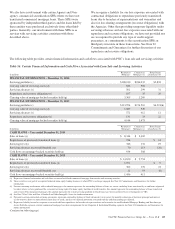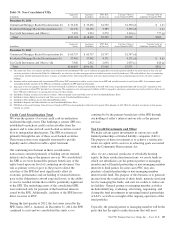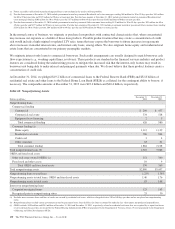PNC Bank 2014 Annual Report Download - page 138
Download and view the complete annual report
Please find page 138 of the 2014 PNC Bank annual report below. You can navigate through the pages in the report by either clicking on the pages listed below, or by using the keyword search tool below to find specific information within the annual report.
Consumer Lending Quantitative Component
Quantitative estimates within the consumer lending portfolio
segment are calculated primarily using a roll-rate model based
on statistical relationships, calculated from historical data that
estimate the movement of loan outstandings through the
various stages of delinquency and ultimately charge-off over
our loss emergence period.
Qualitative Component
While our reserve methodologies strive to reflect all relevant
risk factors, there continues to be uncertainty associated with,
but not limited to, potential imprecision in the estimation
process due to the inherent time lag of obtaining information
and normal variations between estimates and actual outcomes.
We provide additional reserves that are designed to provide
coverage for losses attributable to such risks. The ALLL also
includes factors that may not be directly measured in the
determination of specific or pooled reserves. Such qualitative
factors may include:
• Industry concentrations and conditions,
• Recent credit quality trends,
• Recent loss experience in particular portfolios,
• Recent macro-economic factors,
• Model imprecision,
• Changes in lending policies and procedures,
• Timing of available information, including the
performance of first lien positions, and
• Limitations of available historical data.
Allowance for Purchased Non-Impaired Loans
ALLL for purchased non-impaired loans is determined based
upon a comparison between the methodologies described
above and the remaining acquisition date fair value discount
that has yet to be accreted into interest income. After making
the comparison, an ALLL is recorded for the amount greater
than the discount, or no ALLL is recorded if the discount is
greater.
Allowance for Purchased Impaired Loans
ALLL for purchased impaired loans is determined in
accordance with ASC 310-30 by comparing the net present
value of the cash flows expected to be collected to the
recorded investment for a given loan (or pool of loans). In
cases where the net present value of expected cash flows is
lower than the recorded investment, ALLL is established.
Cash flows expected to be collected represent management’s
best estimate of the cash flows expected over the life of a loan
(or pool of loans). For large balance commercial loans, cash
flows are separately estimated and compared to the recorded
investment at the loan level. For smaller balance pooled loans,
cash flows are estimated using cash flow models and
compared at the risk pool level, which was defined at
acquisition based on the risk characteristics of the loan. Our
cash flow models use loan data including, but not limited to,
delinquency status of the loan, updated borrower FICO credit
scores, geographic information, historical loss experience, and
updated LTVs, as well as best estimates for changes in
unemployment rates, home prices and other economic factors,
to determine estimated cash flows.
See Note 3 Asset Quality, Note 4 Purchased Loans, and Note
5 Allowances for Loan and Lease Losses and Unfunded Loan
Commitments and Letters of Credit for additional loan data
and application of the policies disclosed herein.
Our credit risk management policies, procedures and practices
are designed to promote sound lending standards and prudent
credit risk management. We have policies, procedures and
practices that address financial statement requirements,
collateral review and appraisal requirements, advance rates
based upon collateral types, appropriate levels of exposure,
cross-border risk, lending to specialized industries or borrower
type, guarantor requirements, and regulatory compliance.
Allowance for Unfunded Loan Commitments and
Letters of Credit
We maintain the allowance for unfunded loan commitments
and letters of credit at a level we believe is appropriate to
absorb estimated probable credit losses on these unfunded
credit facilities as of the balance sheet date. We determine the
allowance based on periodic evaluations of the unfunded
credit facilities, including an assessment of the probability of
commitment usage, credit risk factors, and, solely for
commercial lending, the terms and expiration dates of the
unfunded credit facilities. Other than the estimation of the
probability of funding, the reserve for unfunded loan
commitments is estimated in a manner similar to the
methodology used for determining reserves for funded
exposures. The allowance for unfunded loan commitments and
letters of credit is recorded as a liability on the Consolidated
Balance Sheet. Net adjustments to the allowance for unfunded
loan commitments and letters of credit are included in the
provision for credit losses.
See Note 3 Asset Quality and Note 5 Allowances for Loan and
Lease Losses and Unfunded Loan Commitments and Letters
of Credit for additional loan data and application of the
policies disclosed herein.
Mortgage And Other Servicing Rights
We provide servicing under various loan servicing contracts
for commercial, residential and other consumer loans. These
contracts are either purchased in the open market or retained
as part of a loan securitization or loan sale. All newly acquired
or originated servicing rights are initially measured at fair
value. Fair value is based on the present value of the expected
future net cash flows, including assumptions as to:
• Deposit balances and interest rates for escrow and
commercial reserve earnings,
• Discount rates,
120 The PNC Financial Services Group, Inc. – Form 10-K



